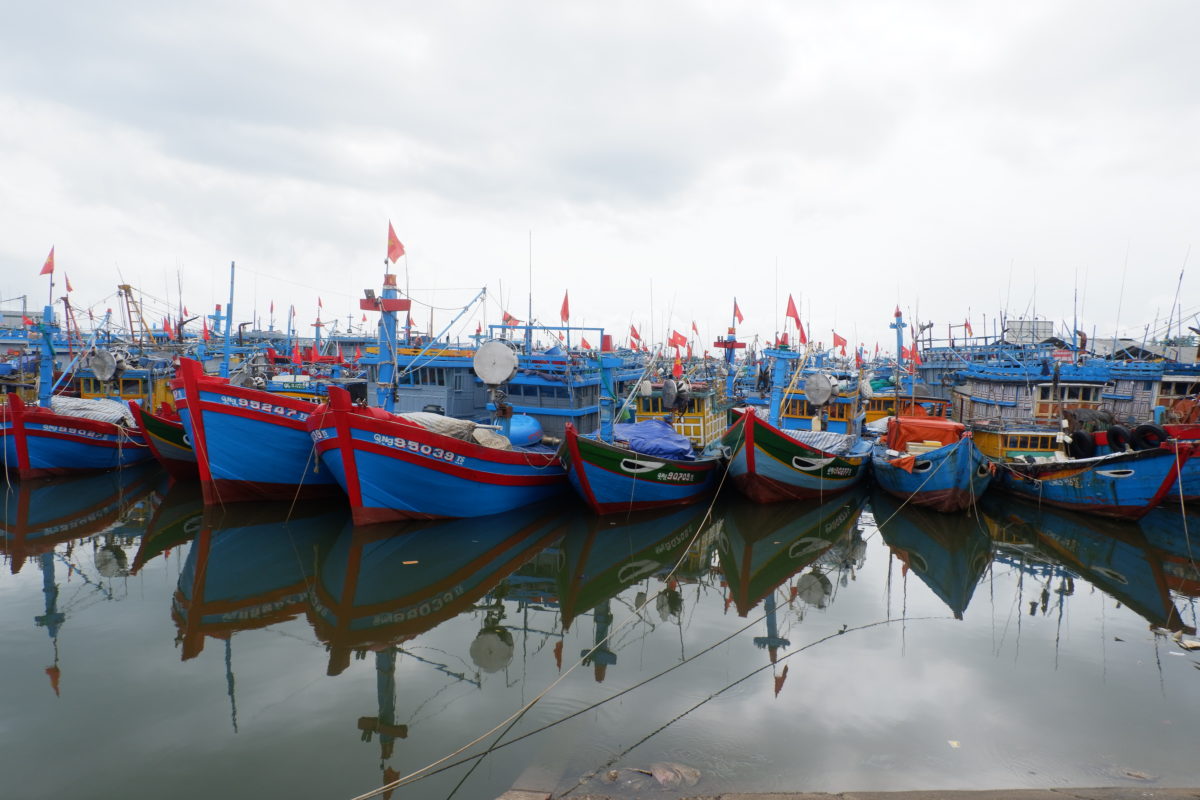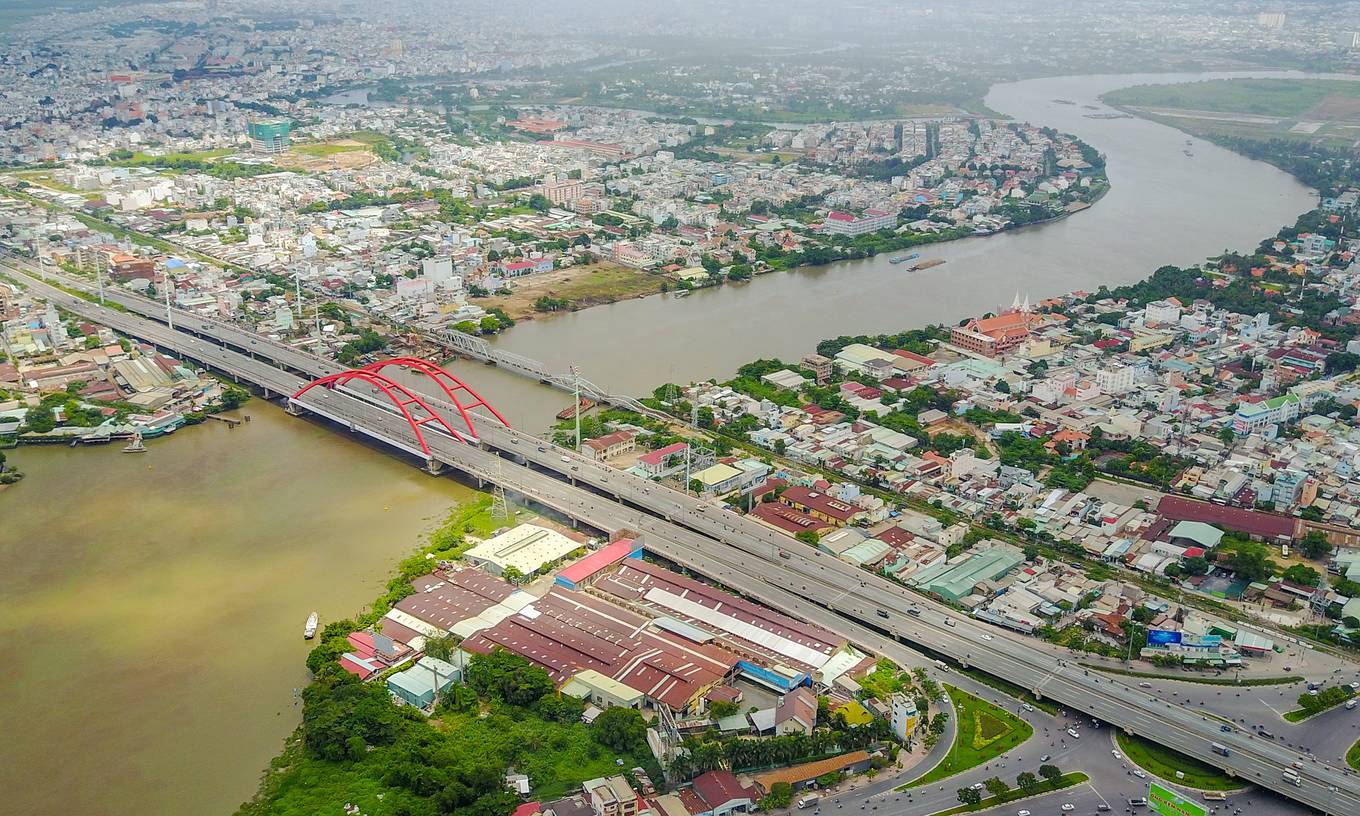Depleted coastal fishing grounds and Chinese incursions have made life harder for Vietnam’s struggling fishermen.
In a cell at Tanjung Pinang in Riau, Indonesia, 64-year-old Vietnamese fisherman Nguyen Van Tu struggles alone with aching legs. He has not been found guilty of any crime, but has been detained for more than 20 months.
In the summer of 2020, the pair of fishing vessels Tu worked on were caught illegally casting their trawling nets in Indonesian waters. This was Tu’s first trip on the blue wooden vessels. Before that, he spent more than three years working on a similar pair of trawlers in the South China Sea.
“Because the nets near the Vietnamese shore were empty, I had to look for vessels that went further. Sometimes they go into the waters of Malaysia and Indonesia,” Tu said.
Under Indonesian law, hired fishermen are not punished and are often released after a month of detention. However, Tu can’t afford the plane ticket home and has been stuck in the Indonesian prison.
There are hundreds of other Vietnamese fishermen like Tu languishing in prisons across the Asia-Pacific region while their impounded fishing vessels fall into disrepair at ports, according to a report by the Environmental Justice Foundation (EJF).
The Vietnam Coast Guard’s website states that from 2017 to 2020, thousands of fishermen on more than 1,000 Vietnamese fishing boats were detained by the forces of other countries.
In 2017, Vietnam had its first warning from the European Commission (EC), as part of its efforts to combat unreported and unregulated fishing activities (IUU). Officially, this is referred to as a “yellow card.”
The EC’s warning was a reaction after several Vietnamese fishing vessels were caught in foreign waters, where they do not have a right to fish. The decision does not, at this stage, entail any measures affecting trade, but all seafood shipments originating from Vietnam are inspected when exported to the EU market, causing difficulty for exporters because of lengthy customs clearances and high export costs.
The desperation of Vietnamese fishermen, imprisoned for months in cells abroad, underscores the human rights abuses committed by vessel owners, and exposes the unsustainable exploitation of Vietnam’s fishing industry ― the world’s fourth-largest seafood exporter.
Not only has the South China Sea become a hotbed of tension over sovereignty disputes among the 10 countries and territories in Asia for decades, now its ecosystem, which includes Vietnamese waters, is also on the verge of collapse.
Drawn across the border
In June 2020, a wooden boat left Kien Giang province on Vietnam’s Mekong Delta with 18 crew members including Tu, heading to the south of the South China Sea.
On this voyage, it was accompanied by a smaller ship. After more than three days, they reached the waters off Indonesia. At this time, the captain turned off their satellite-positioning device to escape the notice of the Vietnamese authority’s tracking service.
Since 2018, Vietnam has mandated that ship owners and captains keep satellite-positioning devices turned on around the clock while fishing offshore, a move to curb IUU fishing and get the European Commission’s yellow card on Vietnamese seafood lifted.
With the tracker off, the captain ordered his crew to cast out the net.
They were seeking a high-value catch such as tuna, mackerel, snapper, grouper, lobster and sea cucumber. Tu said he did not know the two vessels had sailed into the Indonesian Exclusive Economic Zone until they were surrounded by Indonesian coast guard vessels.
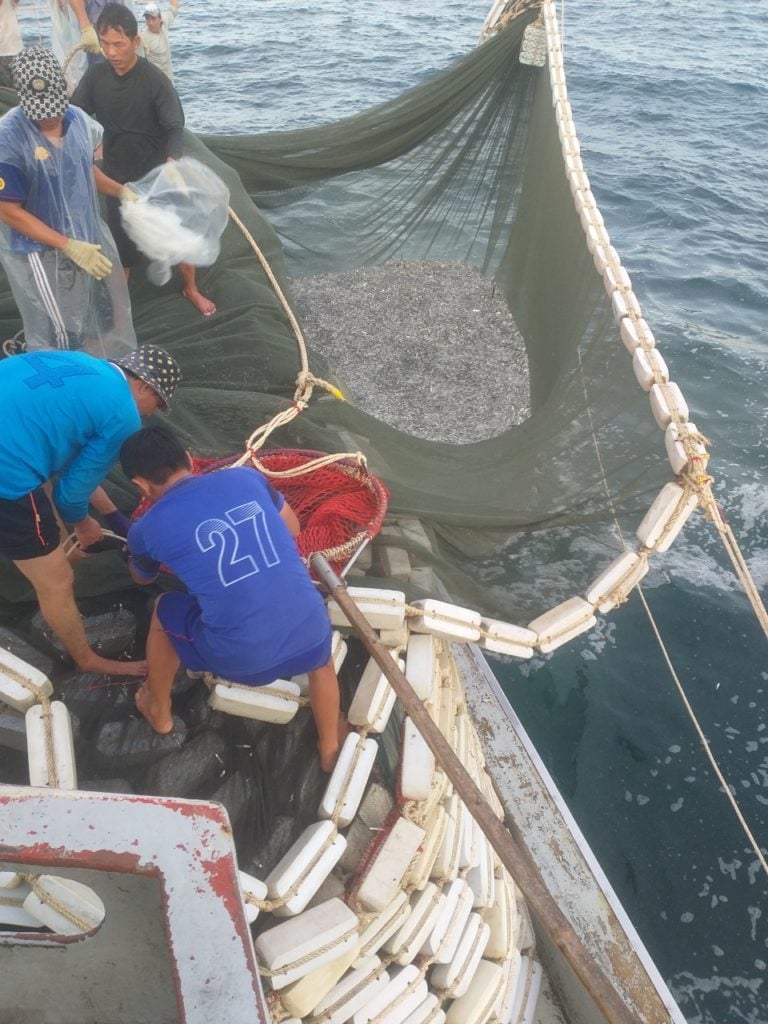
“The two ships operated in parallel with each other, pulling the net, several kilometers long, behind them. The meshes were very tiny, so it captured all creatures: squid, lobster, tortoise, turtle, big fish, baby fish, even coral,” said Tu, while he was locked alone in a tiny room due to suspicion of leprosy.
The detained fishermen are still allowed to use their phones and can take walks in the prison at fixed hours of the day. One of Tu’s compatriots lent Tu his phone to talk to this reporter.
“Sometimes the captains were fascinated by following schools of fish and going into other waters without notifying the crew,” he recalled.
“Fish in the waters of Indonesia and Malaysia are more numerous and larger. Fish in the sea of Vietnam only weigh 1-3kg, while there, the fish are 6-7kg or more,” he said. The attraction of the lucrative fishing grounds pulled the fishermen away from Vietnam’s waters.
The ships and their crew worked day after day at sea. The mother ship Tu worked on could carry roughly 200 tons of fish.
Every 10 days or two weeks, when the ship would approach capacity, the boat owner would send a logistics vessel from the mainland to supply fuel, ice and food to the fishermen, and then transport the catch to the port and sell it to seafood export companies.
“The logistics vessel helped the pair of trawlers stay longer out at sea, for some three months. The rake nets worked almost without a break in the ocean,” recalled the emaciated man from prison.
Tu said that his fishing vessel wasn’t the biggest in Kien Giang. Others could carry more than 500 tons. Tu was in charge of cooking and sorting the caught fish.
“Because the net mesh was very small, the boat also caught a lot of baby fish. They are only as big as a big toe and are processed into fertilizer by buyers,” the fisherman said.
“I know this is bad as baby fishes could not grow and reproduce, but I did not have the right to decide to stop this. The owner on the mainland, the captain and many other crew members did not care about this. They just want the net to be as heavy as possible.”
Each crew was paid based on the number of days worked and the number of fish caught. The fishermen often get about $1,500 for three months’ work. Tu said he received only about $600 because his productivity was underestimated.
In order to increase their catch, in recent years many Vietnamese fishermen have intentionally strayed into the waters of Malaysia, Indonesia, Thailand and even further afield.
According to the Ministry of Agriculture and Rural Development, in the first five months of 2021, there were 32 cases involving 56 ships and 446 people violating IUU fishing regulations.
In particular, the Vietnamese port of Kien Giang is known as the country’s hotspot because of the number of fishing vessels from there violating foreign waters. To get the IUU yellow card removed, one of the important tasks for Vietnam is to stop vessels from going into foreign waters.
“This has been going on for many years and shows no sign of ending,” a Department of Agriculture and Rural Development report into the fishing industry in Kien Gang province found.
After four years, Vietnam’s fishing industry has been unable to reform and now it also faces the prospect of getting a red card. Once this happens, a complete ban on fish exports to the EU will be enforced.
The empty shores
Using nets that cause harm to the ocean is not a new development for Vietnamese offshore fishing boats. The nets have been used for decades on small boats along Vietnam’s coast.
Before becoming an offshore fisherman in 2018, Tu spent more than five years working on small boats that fished near the shore, leaving the port early in the morning and returning in the late afternoon.
“Near-shore boats often used small-mesh nets and caught schools of fish that were coming close to the shore to lay eggs. The fish later moved to other places,” Tu said, acknowledging the consequences of these nets which catch all fish, regardless of their size and maturity.
“But the numbers of fish were becoming less and less, and fishermen must catch a lot of fish to be able to feed their wives and children. We fishermen are the breadwinners of our families,” he said.
At the time, he earned nearly $10 a day, which was enough to sustain him and his family. But as the catches dropped, his income dwindled to almost nothing. There were many trips without a single fish being caught in the net.
“Because the nets near the shore were nearly empty, I had to look for ships that went further in the East Sea,” recalled Tu, using the Vietnamese term for the South China Sea.
A clear sign that Vietnam’s fish stocks are depleting is the steady increase in imports of fresh and frozen seafood products, even though the country has a large and growing fleet of trawlers.
According to the Environmental Justice Foundation’s report, in 2018 imported seafood was worth $1.7 billion, up 30% compared with 2017. The vast majority of these imports are products destined for processing and then re-exported from the country.
At the 2019 annual meeting of the Vietnam Association of Seafood Exporters and Producers, or VASEP, seafood processing and export companies confirmed that because of the depletion of seafood resources, the sailing time for offshore fishing vessels had increased.
Even as the efforts to catch fish increased, the quality has dropped sharply and many catches often failed to meet export standards, forcing companies to import more seafood.
As part of the South China Sea – the planet’s richest marine ecosystem with about 3,365 marine fish species – Vietnam’s near-shore waters were once a source of wealth.
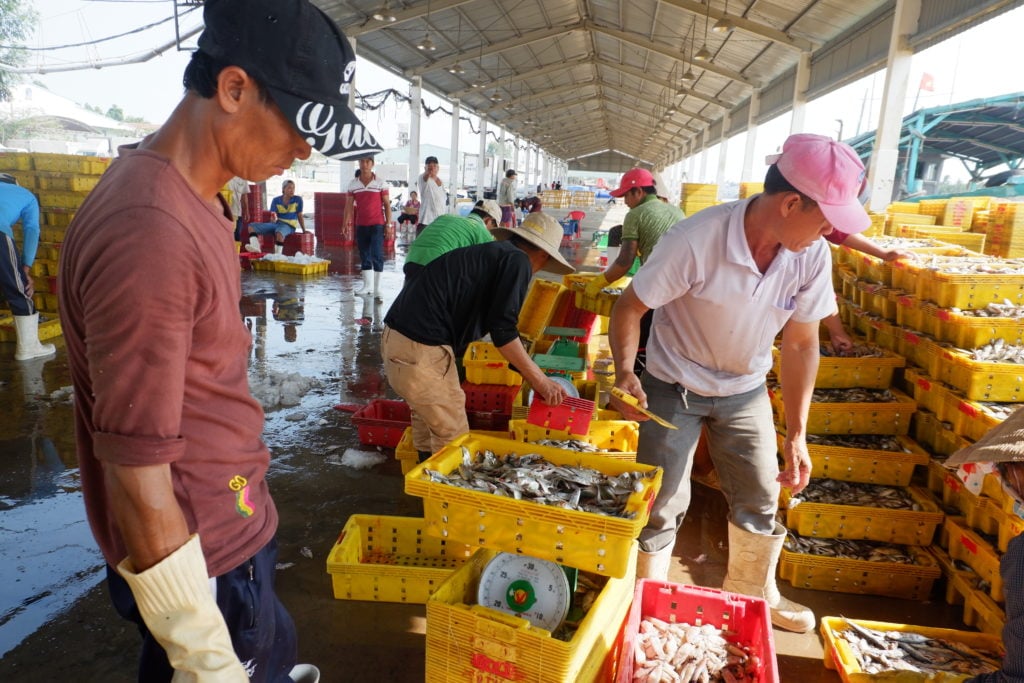
According to Captain Nguyen Thanh, 33, in the early-2000s the waters off Phu Quoc Island in Kien Giang province on Vietnam’s Mekong Delta were always full of fish.
Thanh recalls pulling in nets heavy with fish. He had dropped out of school and started working as a fisherman at the age of 14 and became a captain six years ago. On each of his trips at that time, the fishermen stayed at sea for 20 days a month.
Now, as fish become harder to find, they must stay at sea for almost a month, sometimes up to two months, before returning home with their catch. “The sea near the shore is almost depleted,” Thanh said. “To catch a lot of big fish like tuna and mackerel, the boat has to venture far away.”
His point was echoed in the Environmental Justice Foundation’s report, in which interviews with fishermen showed that internal seafood resources had declined and were often the principal force driving them to fish illegally overseas.
Like Thanh, fisherman Nguyen Thanh Hong in Quang Ngai also used to see large schools of fish in Central Vietnam, but they are now gone.
“There were so many fish, squid and shrimp that we just needed to go to sea in the late afternoon and return the next morning,” he said. The middle-aged man remembers the boat filled with the silver, pink, blue and black colors of seafood.
At that time, most of the boats in his hometown had low capacities, fishing no more than 20 nautical miles from shore.
“We did many types of fishing such as trawling and with seine nets. We even trawled near the shore and we trapped everything: small fish, big fish, shrimp, oysters, squid,” he said.
“Since 1996, fishermen in the commune have used high-pressure lights to shine into the sea to attract fish. When floodlights with a capacity of about 2000W were shone into the sea, loads of anchovies would swim close to the surface and fishermen would just drop the nets and pull them up. But now, the seafood sold is not enough to pay the crew.”
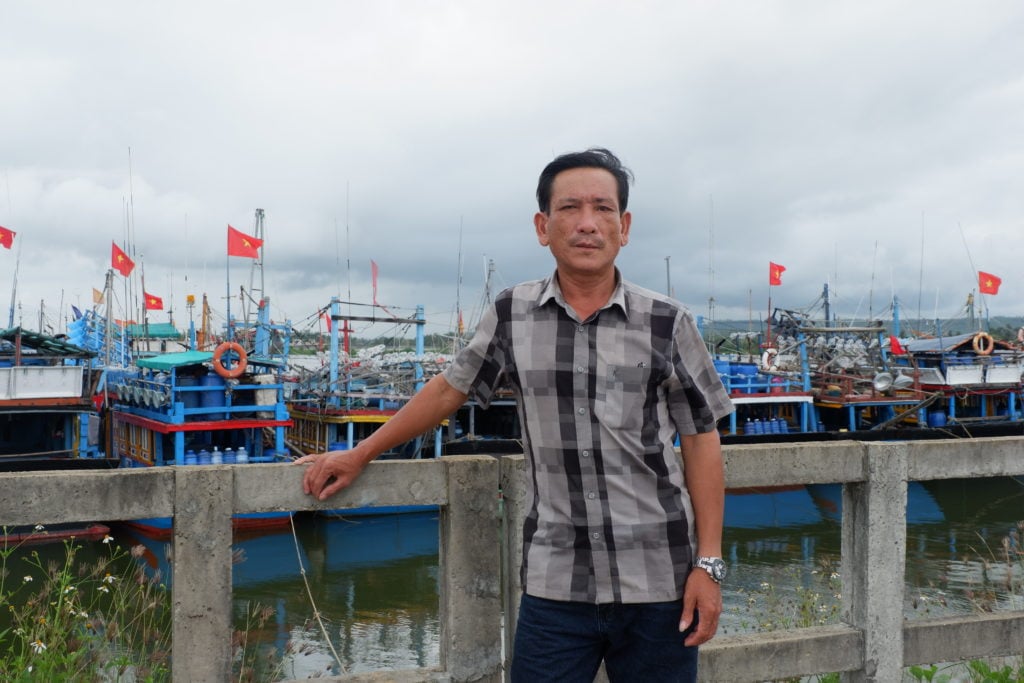
Associate Professor Vu Thanh Ca, a former Director of the Vietnam Institute of Sea and Islands Research, said fisheries in Vietnam’s waters were declining at an alarming rate and marine ecosystems were under threat.
One of the main reasons is fishermen have spent years focusing on fishing near the shore, extracting resources quicker than fish stocks can regenerate.
In some cases, they have used destructive fishing gear such as explosives, poison, high-powered lights, electric shocks, small and thick nets ― gear that catches all types and sizes of fish, including juveniles. Such massive, uncontrolled fishing has driven the fisheries to the point of collapse.
“The government for a long time was either negligent or did not have enough resources to control these activities,” explained Ca.
The writer contacted the Directorate of Fisheries and the Ministry of Agriculture of Vietnam via email and phone, but did not receive a response despite numerous attempts.
Of the 10 criteria that make up Vietnam’s Ocean Health Index Provision score ― the metric which measures how sustainably seafood is harvested ― the country is scored 46 out of 100 in 2021. Overall, Vietnam is ranked 190 out of 220 regions with the healthiest ocean.
This underscores that Vietnam’s current fishing practices are pushing the fisheries sector towards collapse ― a catastrophe for the marine ecosystem, the fishermen who depend on it, and the nation’s food security.
Crowded in a hungry sea
Not only have seafood stocks near the shore dried up, but the catches from faraway grounds have also been disappointing.
For many years the government encouraged fishermen to stick to the sea, backing fishing communities with fuel subsidies. The Vietnam Association of Seafood Exporters and Producers pointed out that fishermen are one of the economic pillars that bring Vietnam no less than $8 billion per year, contributing 4-5% of the country’s GDP.
The presence of fishermen in the South China Sea is also one of the ways Vietnam asserts its sovereignty in its territorial waters. This has led to an explosion in the number of fishing vessels at sea.
According to the General Statistics Office (GSO), in the past 20 years, the number of vessels has increased by nearly 400%, from 9,766 in 2000 to more than 35,000 in 2020. More than half of these ships come from the Central region and more than a quarter come from the Mekong Delta region.
Accompanying the growth in the number of ships was an increase in the vessels’ engine power, which allows them to go out farther and stay out longer. Data from the GSO also revealed that the average capacity per fishing vessel in 2020 was 400 CV (nearly 395 Horsepower), which is almost triple the figure from the last 10 years.
Among the top three provinces that contribute the most capacity, two are from the Central region ― Binh Dinh and Quang Ngai ― while the other is from the Mekong Delta region, Kien Giang. With bigger engines and hulls, fishermen catch more fish, exhaust available fish supplies faster and disrupt fish reproduction.
Apart from the intense competition with each other, Vietnamese fishermen are also wary of constant danger in their waters: Chinese vessels.
“The fishery needs of this country’s 1.4 billion people are overwhelming and in order to meet them, China’s fishing fleets have to go further into the oceans, spilling out into territorial waters. Chinese fishing boats excavated everywhere in the South China Sea, crowding out neighboring countries in the region,” said Nguyen The Phuong, a collaborative research fellow at the Center for International Studies, University of Social Sciences and Humanities, National University of Ho Chi Minh City.
Phuong is a member of the South China Sea Chronicle Initiative, a non-profit, independent project studying disputes in these waters.
On trips to the Spratly and Paracel islands, two fishing grounds believed to be an abundant source of fish in Vietnam, Hong from Quang Ngai and his fellow fishermen often encounter fishing fleets consisting of large steel-hulled vessels sporting Chinese flags.
“Each group has 20-30 boats 60 meters long, 2-3 times bigger than Vietnamese wooden ships, using rake nets and giant ‘small eyed-nets’ to catch all kinds of fish. Chinese Coast Guard boats follow the fleet to protect them. When they see Vietnamese fishermen’s vessels approaching, they chase us away,” Hong recalled.
“The Vietnamese Coast Guard is not capable of protecting fishermen operating in the East Sea.”
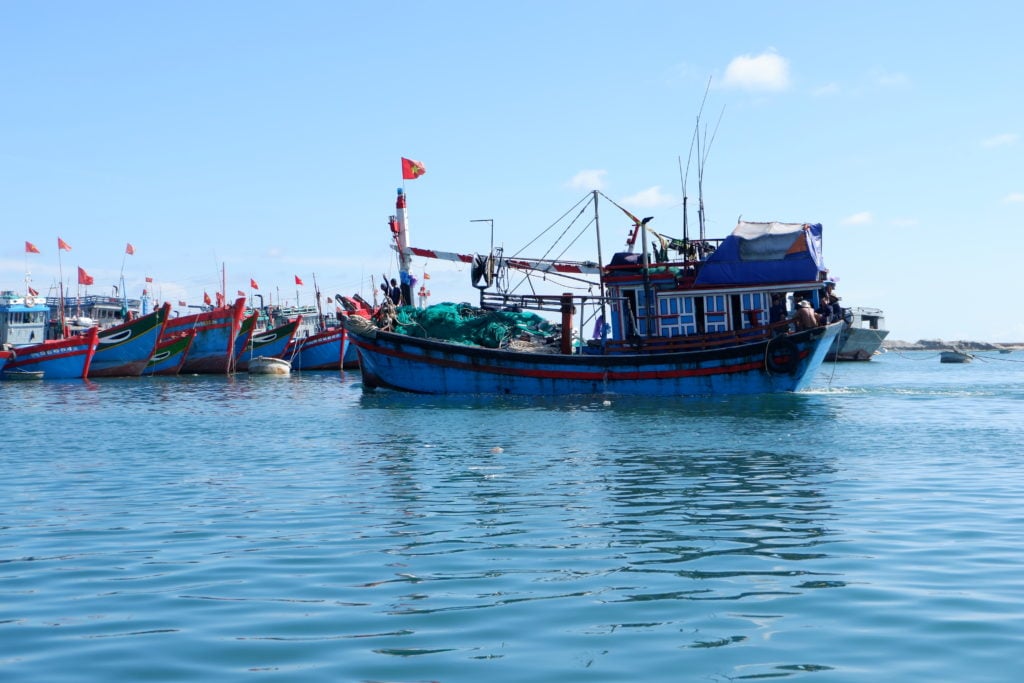
For many years, Vietnamese fishermen have been attacked by Chinese Coast Guard ships while fishing in their claimed territorial waters. Many times, they’ve rammed and sunk Vietnamese fishing boats, and even arrested fishermen.
Hanoi has repeatedly condemned Beijing as having infringed upon its sovereignty and endangered the lives and properties of its fishermen.
In 2017, Hong was one of the first five fishermen in Quang Ngai province selected by a bank and the provincial government to receive a low-interest shipbuilding loan ― the state’s way of encouraging fishermen to catch fish offshore and at the same time increasing the strength of Vietnamese fishing fleets to counter China.
But this investment has been a failure as the South China Sea is no longer rich in fish and is unable to support all the fishing fleets, which are getting bigger and bigger.
“I thought it was a way to continue fishing as the sea near the shore was empty of fish. I would go to our country’s further seas where there’s an abundance of big fish,” Hong said.
The sturdy, steel-hulled vessel sailing thousands of nautical miles, with a load of several hundred tons of fish, is still imprinted in his mind. But that dream ended after only three years when the vessel hit heavy seas.
“Even when going far from the shore, there are not always many fish. We were at sea for a month with a modern ship and came back with less fish than we caught 20 years ago when using just a wooden boat near the shore,” fisherman Quang Ngai said, his voice choking.
At the age of 51, the veteran fisherman is drowning in debt. His steel-hulled vessel has also been confiscated by the bank.
Like Hong, hundreds of fishermen are in debt, something acknowledged by local and central authorities. Two years ago, Vietnam’s Minister of Agriculture and Rural Affairs admitted at a National Assembly session that many steel-hulled ships built under the interest rate subsidies had stopped working.
One of the reasons given by the ministry’s representative was that “the fishing vessels are not efficient, because the fishing grounds are now overloaded.”
In March, the Fisheries Sub-Department of Quang Ngai announced about 80% of steel-hulled ships in the province had gone bankrupt, “due to the depletion of aquatic resources caused by the rapid increase in gill nets and excessive fishing.”
Any chance left for Vietnam’s waters?
Any solution to protect and restore the marine environment is now tied to the Vietnamese government’s at-all-cost efforts to have the EU yellow card lifted. It has now become a political task from central to local levels.
Last year, Prime Minister Pham Minh Chinh asked relevant government ministries and the governments of coastal provinces and cities to “definitively by the end of 2021 remove the IUU yellow card.” This task is especially pressing in light of the economic damage the fishing industry is suffering.
According to the Vietnam Association of Seafood Exporters and Producers (VASEP), the EC’s move led to a decrease in Vietnam’s seafood exports to the European Union by $183.5 million from mid-2017 to the end of 2019.
Exports continued to fall further in 2020 due to the dual impact of the IUU “yellow card” and the Covid-19 pandemic. Since 2019, the EU has dropped from 2nd to 4th place in Vietnam’s import markets, after the US, Japan and China.
If the IUU fishing dispute is not resolved this year, Vietnam will be identified as a non-cooperative country and most likely the penalty card will turn red. At that point, the seafood industry will suffer a loss of $573 million per year, as predicted by the VASEP in collaboration with the World Bank.
Professor Vu Thanh Ca, a former Director of the Vietnam Institute of Sea and Islands Research, said that before the IUU yellow card, although Vietnam’s fishing regulations existed in legal documents, they seemed to be absent in practice.
In the last few years, in an effort to get the yellow card lifted, the government tightened regulations governing the activities of fishing boats. The measures included requiring a locator for authorities to track every vessel’s journey and increasing the fine to 1 billion dong for violations (nearly $44,000), 10 times higher than before.
In addition, fishing vessels found to be in violation would also have their fishing vessels confiscated, their fishing licenses revoked from six to 12 months and their fuel subsidies cut off.
According to Nguyen The Phuong, a collaborative research fellow at the Center for International Studies at the University of Social Sciences and Humanities, the policies imposed come too late to help the critical state of the fishing grounds.
“It looks like it is too late to lock the barn door after the horse is gone,” Phuong said, adding that Vietnam’s coast guard resources were too thin to enforce these policies.
“Shipowners must sign an undertaking to only fish in Vietnamese waters with legal fishing gear. But compliance is up to each person. I know many violators, but they still don’t get fined,” said captain Thanh from Kien Giang.
At night near Phu Quoc Island, the captain sometimes hears mines exploding in the fishing grounds, which causes not only mass fish deaths, but also kills the coral in the area, destroying the habitats of fish and other marine life.
“Fishermen have many ways to hide this from the Vietnamese authorities. Fishermen are afraid of being caught and fined, but they are also afraid of going hungry and being in debt,” Thanh said.
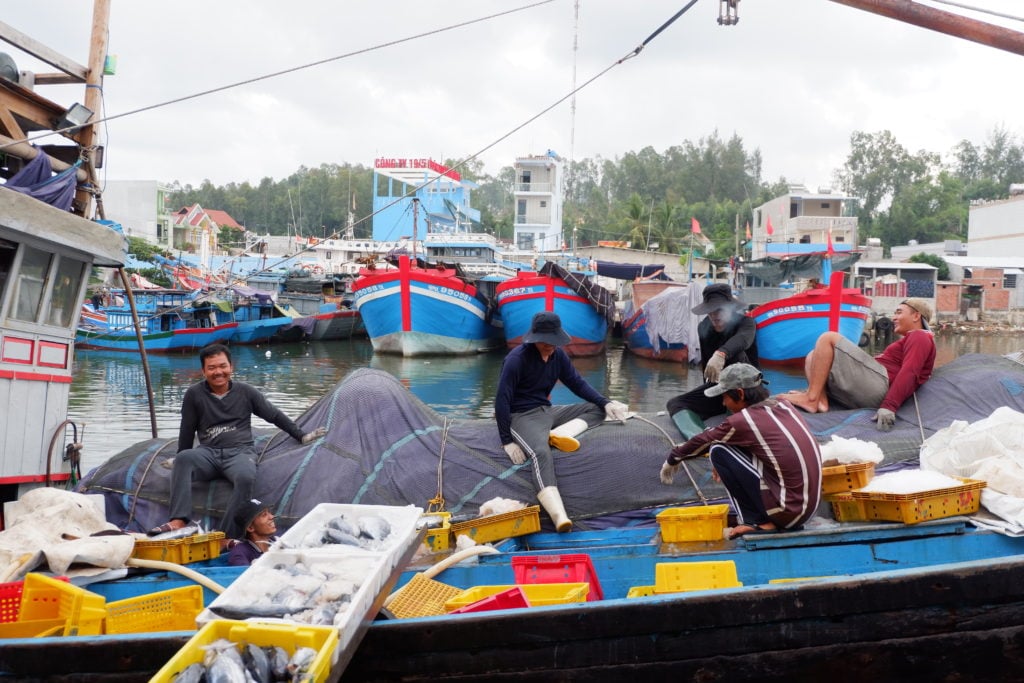
The policy of focusing on sanctions is not enough to remove the EC’s gaze, much less rescue a marine ecosystem that is on the verge of exhaustion, said Ca.
In desperation, fishermen who are encouraged to go to sea may see no choice but to risk their lives crossing into other waters or fishing without considering the long-term sustainability.
According to Ca, the chance for Vietnam’s South China Sea ecosystem to recover, and safeguard the fishermen’s livelihood and security, is increasingly slim and will be hopeless without immediate prompt action.
“What needs to be done, is to reduce the frequency of fishing activities at sea by limiting the time of fishing in the year and increasing marine biodiversity conservation areas where fishing is prohibited so that fishing grounds have a chance to recover,” said the former Director of the Vietnam Institute of Sea and Islands Research.
Another solution would be to immediately reduce the number of new ships in each locality, and at the same time have a plan to offer alternative livelihoods to the fishermen, he added.
According to Vu Ke Nghiep, who specializes in research on fishing at Nha Trang University, this solution would have to be a long-term persistent effort as most fishermen have low education levels.
According to the UN Environment’s report published in 2019, it is estimated that 70% of people in these communities only complete primary school, and less than 1% have graduated from vocational schools or universities.
“We can only hope for future generations. Nha Trang University has organized educational programs for fishermen’s children. This generation will sail on modern vessels and be knowledgeable about the law and the environment,” said Nghiep.
Meanwhile, in Hong’s village, only people around his age or older still go to sea. As for Thanh, his trips to the sea have become increasingly difficult because it’s hard to find other fishermen. The risks and uncertainties of the marine industry are what have been driving young people away from it.
As for Tu, with each passing day, his despair grows. He is afraid of being trapped in a foreign prison forever.
“One day, if I can get out of here and return to Vietnam, I won’t be a fisherman anymore. I’m afraid to see the sea and the ships,” said the old fisherman, hugging his crossed legs while squatting behind the cell bars.
This story is supported by the Mekong Data Journalism Fellowship jointly organized by Internews’ Earth Journalism Network and the East-West Center.
Methodology: Data on Vietnamese fishery production and capacities was provided by Vietnam’s General Statistics Office. Trade data on Vietnam’s seafood exports was taken from ResourceTrade.Earth, which is developed by an independent think tank, Chatham House, who sourced and re-adjusted bilateral trade data from UN Comtrade. This was complemented with data from Vietnam Association of Seafood Exporters and Producers. To assess the conditions of Vietnamese seawaters, the author referred to the Ocean Health Index, which is a research collaboration between the National Center for Ecological Analysis and Synthesis from University of California, Santa Barbara and Conservation International, with scores contributed by independent research teams. Data findings were cross-checked and validated during interviews with 3 experts including one environmental expert working at Vietnam Institute of Sea and Islands Research, one expert specializing in fishery economics research at Nha Trang University (Vietnam) and one political researcher at the Center for International Studies, University of Social Sciences and Humanities, Vietnam National University-HCMC and the South China Sea Chronicle Initiative; three fishermen including two in the Vietnam Mekong Delta and one in the Central Vietnam. The reporter contacted (via email and phone) the Directorate of Fisheries – Ministry of Agriculture of Vietnam, but did not receive a response. The links to all the data sources and analyses have also been compiled in this Google Sheet.


